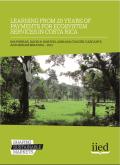This study examines the ecological and socioeconomic effects of the Chinese Natural Forest Conservation Programme (NFCP) and the Grain to Green Programme (GTGP), which initially invested more than US$95 billion in forest conservation and related economic development efforts over thirteen years (1998 to 2010). The NFCP conserves natural forests through logging bans and afforestation with incentives to forest enterprises, whereas the GTGP converts cropland on steep slopes to forest and grassland by providing farmers with grain and cash subsidies.
This case study assesses the efficacy of the Environmental Stewardship scheme in England to drive changes in national farmland bird populations over the period 2002-2010. It tests for associations between environmental stewardship management options, grouped into categories reflecting intended biological effects (e.g. the presence of stubble, or straw that remains after grains have been harvested) and species’ population growth rates, wherever benefits of management might be expected to occur.
This case study calculates a hazard index for every square kilometer of the United States coastline using five sea-level-rise scenarios. This index is then used to identify the most vulnerable people and property as indicated by being in the upper quartile of hazard for the nation’s coastline. The study delivers the first national map of risk reduction owing to natural habitats and thus indicates where conservation and restoration of reefs and vegetation have the greatest potential to protect coastal communities.
This summary reports on a pilot Payment for Ecosystem Services (PES) project funded by South West Water in the catchment of the River Fowey in Cornwall. The scheme looks to fund capital investments on farms that will serve to improve water quality in the River Fowey. This report follows and documents the process of designing and implementing the PES scheme as well as providing an evaluation of the successes and failures of that process in order to provide insights into issues that might arise in similar projects across the United Kingdom.

This case study discusses the history, contributions, and hurdles faced by Costa Rica’s payment for ecosystem services (PES) programme, which was one of the first nationalized programmes of its kind. It also provides clear and concise recommendations of how the programme could be improved to balance conservation goals, development goals, and the provision of ecosystem services.

This resource is also available in English.
This case study discusses the history, contributions, and hurdles faced by Costa Rica’s payment for ecosystem services (PES) programme, which was one of the first nationalized programmes of its kind. It also provides clear and concise recommendations of how the programme could...
This study introduces an approach for assessing the combined risk to marine habitats from multiple human activities, and applies it to coral reefs, mangrove forests, and seagrass beds in Belize to inform the design of the country’s first Integrated Coastal Zone Management (ICZM) Plan.
This study assesses changes in 15 different ecosystem services from 26 different soil management measures (e.g. mulching, terracing, no-till) across 16 case study sites in Europe. Overall, the results are positive in terms of the impacts of the measures on ecosystem services, with 18 out of 26 measures having no decrease in any ecosystem service at the plot level.
The Shandong Energy Efficiency and Emission Reduction Project supported by the Asian Development Bank (ADB) highlighted the impact of supporting the industry sector to invest in technology innovations that lead to reduced energy costs and enhanced market competitiveness.
This study looks at various avenues for renewable energy to access capital markets.
